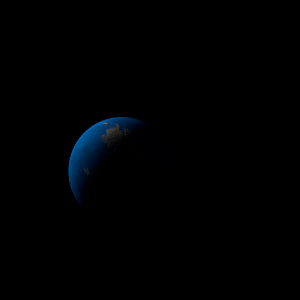| Fictional info (?) |
|---|
| Suggested name | Mida |
| Planet type | Warm planet |
| Its orbital period around Kepler-1655 of 12 earth days is the shortest of all the planets in its solar system. It has the longest rotation period (445 days) of any planet in its solar system and rotates in the opposite direction to most other planets.
It is the coldest planetary atmosphere in its solar system, with a minimum temperature of 65°K (-208°C), and has a complex, layered cloud structure with nitric oxide thought to make up the lowest clouds, and methane the uppermost layer of clouds.
The outer atmosphere is visibly segregated into several bands at different latitudes, resulting in turbulence and storms along their interacting boundaries. |
| Atmosphere | Methane | 89% |
| Nitric oxide | 9.2% |
| Krypton | 1.4% |
| Argon | 4.0E-6% |
| Xenon | 3.0E-6% |
| Atmospheric pressure | 40 bar |
 |
| Moon | Gemu Rare Jate'nyo | Large potato shaped rocky planetoid |
| Heryonyo Biposho | Medium-sized slightly egg-shaped rocky asteroid |
| Tsugyo-shu | Small almost round ice comet |
| Seryoze | Huge almost round rocky moon |
| Shikyu | Large almost round oceanic asteroid |
| Hihabya Ju | Small round ice moon |
| Pyukyu Jinota Ka | Huge slightly egg-shaped rocky planetoid |
| Shihyo-doyonya | Small slightly egg-shaped rocky asteroid |
| Hegakyo Kosu | Medium-sized irregular crater-filled moon |
| Shura Nyacho | Large almost round oceanic planetoid |
| Pyuwo | Huge round gaseous moon |
| Nyazumo Baugu | Small round rocky moon |
| Wobabyo-cha | Small slightly egg-shaped rocky moon |
| Buipu'ryanyu | Small irregular crater-filled comet |
| Ensuto Gobo | Huge potato shaped rocky moon |
| Runokuzu Futebya | Large potato shaped ice comet |
| Byamepu Go | Small irregular oceanic moon |
| Gejono-kyokya | Large irregular oceanic asteroid |
| Himyu Uhyada-ke | Very small slightly egg-shaped rocky asteroid |
| Wobu-bi | Large slightly egg-shaped oceanic asteroid |
| Hyugi Bya | Very small irregular rocky moon |
| Mujizu Ryuhosha | Small potato shaped rocky moon |
| Bushanyo-sujogo | Medium-sized round oceanic moon |
| Wohyo | Large round oceanic asteroid |
| Wobe Sho | Very small round rocky moon |
| Takushu Janyu | Medium-sized round ice asteroid |
| Memyuhe'to | Large potato shaped gaseous moon |
| Adarokya | Very small round rocky planetoid |
| Tedofu Punamyu Shi | Large almost round rocky moon |
| Inyu | Huge slightly egg-shaped crater-filled moon |
| Google search for Mida |